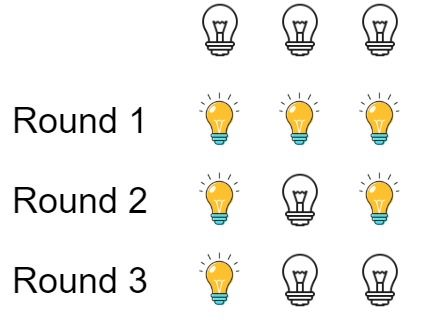| comments | difficulty | edit_url | tags | ||
|---|---|---|---|---|---|
true |
中等 |
|
初始时有 n 个灯泡处于关闭状态。第一轮,你将会打开所有灯泡。接下来的第二轮,你将会每两个灯泡关闭第二个。
第三轮,你每三个灯泡就切换第三个灯泡的开关(即,打开变关闭,关闭变打开)。第 i 轮,你每 i 个灯泡就切换第 i 个灯泡的开关。直到第 n 轮,你只需要切换最后一个灯泡的开关。
找出并返回 n 轮后有多少个亮着的灯泡。
示例 1:
输入:n = 3 输出:1 解释: 初始时, 灯泡状态 [关闭, 关闭, 关闭]. 第一轮后, 灯泡状态 [开启, 开启, 开启]. 第二轮后, 灯泡状态 [开启, 关闭, 开启]. 第三轮后, 灯泡状态 [开启, 关闭, 关闭]. 你应该返回 1,因为只有一个灯泡还亮着。
示例 2:
输入:n = 0 输出:0
示例 3:
输入:n = 1 输出:1
提示:
0 <= n <= 109
我们不妨将
对于一个数
因此,我们只需要找到
对于一个数
举个例子,数字
因此,我们只需要找到
时间复杂度
class Solution:
def bulbSwitch(self, n: int) -> int:
return int(sqrt(n))class Solution {
public int bulbSwitch(int n) {
return (int) Math.sqrt(n);
}
}class Solution {
public:
int bulbSwitch(int n) {
return (int) sqrt(n);
}
};func bulbSwitch(n int) int {
return int(math.Sqrt(float64(n)))
}function bulbSwitch(n: number): number {
return Math.floor(Math.sqrt(n));
}